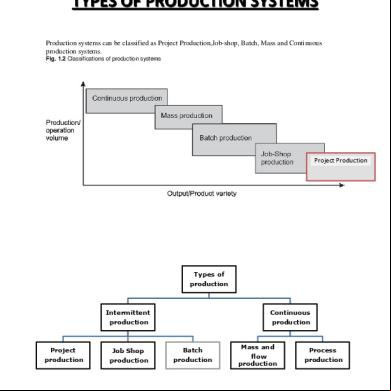Types Of Food Production 381c1q
This document was ed by and they confirmed that they have the permission to share it. If you are author or own the copyright of this book, please report to us by using this report form. Report 3i3n4
Overview 26281t
& View Types Of Food Production as PDF for free.
More details 6y5l6z
- Words: 505
- Pages: 2
Traditional ingredients are assembled and food is produced onsite, held either heated or chilled, and served to customers food is purchased all along the food processing continuum. For example, some items may be purchased from one end and require full preparation. Other items may be purchased with some processing, while others may be purchased fully prepared, only requiring portioning and service. Centralized The commissary food service system (also known as central kitchen, central food production, or food factory) centralizes food production, and food is transported to satellites (receiving kitchens) where it is served to customers. Food usually is purchased near the none end of the food processing continuum, and food preparation is done in the central kitchen, which results in lower food costs. Labor costs also are lower because of the centralization of food preparation. This food service system takes advantage of economies of scale, so it is most effective when mass food production is required. Sous vide Sous vide is a variation of a cook-chill operation. Sous Vide is a cooking method in which food is vacuum sealed in a plastic pouch and then cooked at a gentle temperature in a precisely controlled water bath. Compared to other cooking methods, it provides more control and allows for perfect, repeatable results every time. It is easy to learn and takes the stress out of cooking, because food can be held at a perfect level of doneness for a much longer time than usual methods allow. Cook-Chill Cook-chill is a process that uses both heat and cold for batch food production. Temperature monitoring and recordkeeping are critical in production of cookchill products to avoid foodborne illness. Not all food products can be cookchill processed. Advantages are higher efficiency and lower food costs based on bulk buying and centralized purchasing while disadvantages number temperature control which may compromise food safety and nutritional content Cook-freeze This system is similar to cook-chill, except the food is frozen rather than chilled. After cooking, dishes are blast-frozen to a temperature of –200C and kept at this temperature until required. Storage at frozen temperatures can be more prolonged, for up to two years. When required the food is defrosted and regenerated to a core temperature of at least 70 - 750C (Department of Health, 1989). The disadvantage of this system is a loss of texture owing to the freeze/thaw process involved and subsequent regeneration and distribution to the wards (Hwang et al, 1999). Assembly
The assembly-serve foodservice system traditionally has been the least common, although that is changing due to the current operating environment. In today’s environment labor is scarce and expensive. Also, there are many choices in foods that can be purchased that only require heating and serving. In assembly-serve foodservice systems, food is purchased at the middle to complete end of the food processing continuum. The purchased food is stored either frozen or chilled for later use. It is then portioned, reheated, and served to customers.
The assembly-serve foodservice system traditionally has been the least common, although that is changing due to the current operating environment. In today’s environment labor is scarce and expensive. Also, there are many choices in foods that can be purchased that only require heating and serving. In assembly-serve foodservice systems, food is purchased at the middle to complete end of the food processing continuum. The purchased food is stored either frozen or chilled for later use. It is then portioned, reheated, and served to customers.





